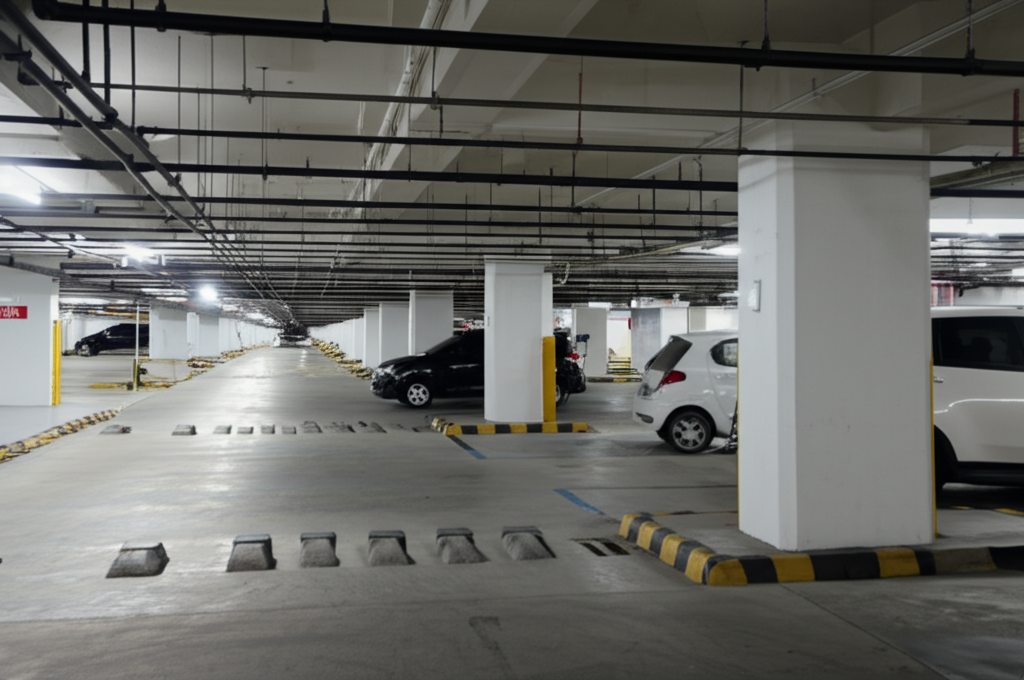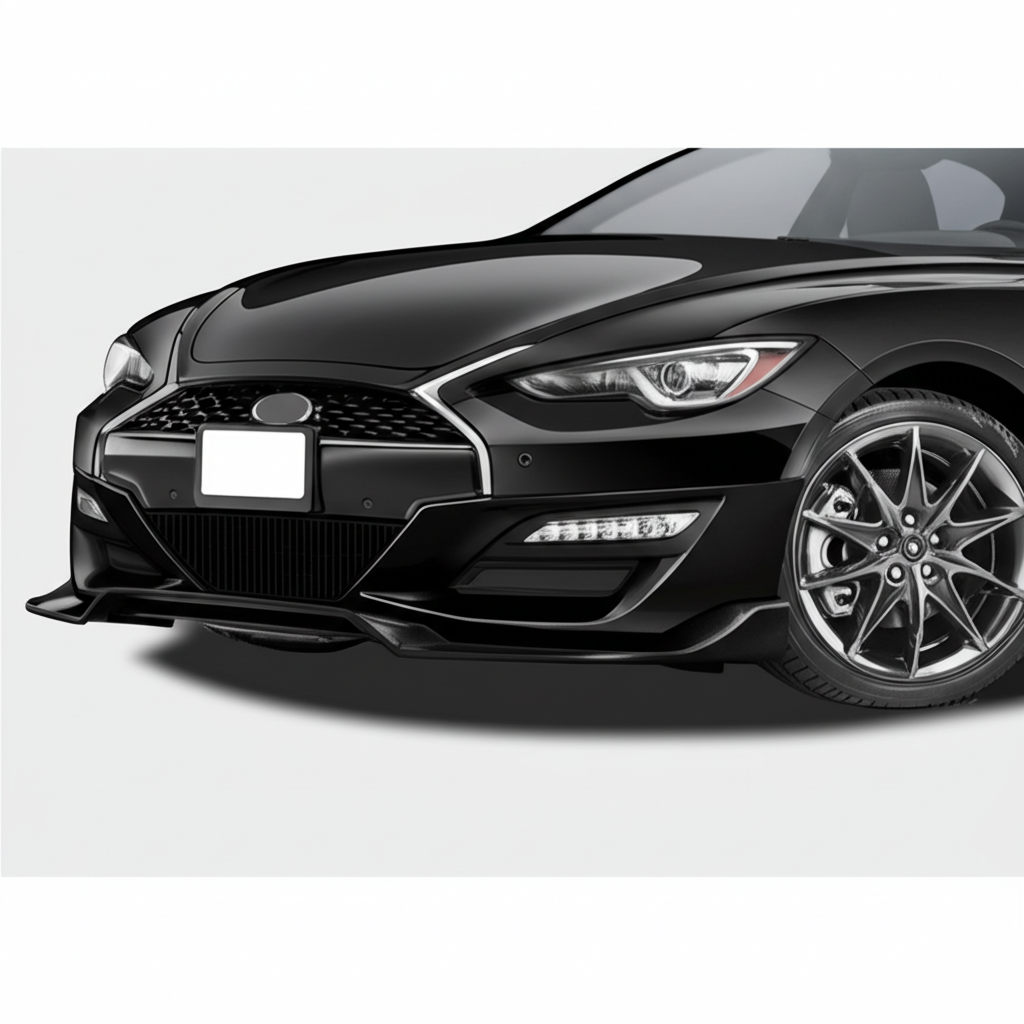We’ve all been there. Navigating the notoriously tight parking spaces in Bangkok’s condos or squeezing through a narrow soi (alley). You hold your breath, inch forward, turn the wheel… and then you hear it. That heart-stopping *SCRAPE*. It’s the sound of your pristine paintwork meeting unforgiving concrete. For many drivers in Thailand, especially those dealing with challenging urban parking daily, the front bumper corners (the ‘lips’ or ‘chin’) and the outer edges of side mirrors are prime targets for accidental scrapes and scuffs. It’s frustrating, costly to repair repeatedly, and frankly, it ruins the look of your beloved car. Does protecting your entire vehicle with Paint Protection Film (PPF) feel like overkill, or perhaps stretch the budget too far? You’re not alone in wondering: is there a more focused, cost-effective way to guard against these common battle scars? Could strategically applying TPU film *only* to these high-risk areas be the smarter solution?

Meet Khun Anan, a marketing executive working near Sukhumvit. He recently purchased a new Honda Civic, his pride and joy. However, the multi-level underground parking at his office building and the narrow entrance to his condo’s parking lot quickly turned ownership joy into daily anxiety. Within the first three months, he’d already collected minor scrapes on both front bumper corners and the driver’s side mirror housing. “Each scratch felt like a personal failure,” Anan shared. “I was getting quotes for repainting, but I knew it would just happen again. I considered a full PPF wrap, but the cost for a quality job felt substantial, especially when only specific parts were constantly getting hit.”
Frustrated, Anan started researching alternatives. He discovered the concept of partial PPF application, specifically using high-quality Thermoplastic Polyurethane (TPU) film known for its self-healing properties and durability. He visited a reputable auto detailing shop in Bangkok that specialized in PPF. After discussing his driving habits and parking challenges, the technicians recommended applying TPU film strategically: covering the entire front bumper lip (especially wrapping around the vulnerable corners) and the painted caps of his side mirrors. The process involved meticulous cleaning of the target areas, precise computer-cutting of the TPU film to match the exact contours of his Civic’s bumper and mirrors, and careful application by skilled installers. They ensured the edges were wrapped seamlessly, making the film nearly invisible.
The change for Anan was immediate, though primarily psychological at first. “The biggest difference wasn’t visual – you can barely see the film – it was the peace of mind,” he explained. “Driving into those tight spots, I still concentrate, but I don’t have that constant fear of the inevitable scrape. I know there’s a tough, sacrificial layer protecting my paint.” A few weeks later, while navigating a particularly tight corner near a concrete pillar, he misjudged slightly. He heard a faint brush. Getting out, heart pounding, he expected the worst. Instead, he found only a minor scuff mark *on the film*. Later, after parking in the sun, the light mark had visibly diminished thanks to the TPU’s self-healing properties. “That small investment in partial TPU saved me a repaint job and countless hours of stress. For city drivers like me, focusing protection where it’s needed most just makes financial sense.”

When it comes to protecting your car’s paint, especially in high-risk urban environments, you have several choices. Doing nothing means accepting the inevitable scratches and paying for repairs. A full PPF wrap offers comprehensive protection but comes at a significant cost. Partial TPU application emerges as a compelling middle ground. Let’s break down the key differences:
What is TPU PPF?
TPU stands for Thermoplastic Polyurethane. It’s the industry standard for high-quality Paint Protection Film. Unlike older PVC films, TPU offers superior clarity (it doesn’t yellow easily), flexibility (conforms better to curves), durability, and crucially, ‘self-healing’ properties. Minor scratches and swirl marks on the film’s surface can disappear with exposure to heat (like sunlight or warm water).
Comparing the Strategies:
| Feature | No Protection | Partial TPU (Corners/Mirrors) | Full TPU Wrap |
|---|---|---|---|
| Protection Area | None | Specific high-impact zones (e.g., front bumper corners, mirror caps, door edges, door cups) | All painted exterior surfaces |
| Key Benefit | Lowest initial cost (zero) | Cost-effective protection against common scrapes & scuffs in vulnerable areas; Peace of mind in tight spaces. | Comprehensive protection against scratches, stone chips, swirl marks, bird droppings, etc., across the entire vehicle. |
| Material | N/A (Car’s original paint) | High-quality Thermoplastic Polyurethane (TPU) Film | High-quality Thermoplastic Polyurethane (TPU) Film |
| Typical Lifespan | N/A (Paint degrades with damage) | 5-10 years (depending on film quality, installation, and care) | 5-10 years (depending on film quality, installation, and care) |
| Estimated Cost (Relative – Thailand Market) | ฿0 (initially) + Repair Costs (฿฿฿ per incident) | ฿ – ฿฿ (Moderate one-time cost) | ฿฿฿ – ฿฿฿฿ (Significant investment) |
| Ideal User | Those unconcerned with minor cosmetic damage or with very low risk driving environments. | City dwellers, drivers frequently using tight parking garages/alleys, budget-conscious owners wanting targeted protection for common damage areas. | Owners seeking maximum paint preservation, driving frequently on highways (stone chips), concerned about overall resale value, less budget constrained. |
The key takeaway is that partial TPU application offers a strategic advantage for drivers facing specific, predictable risks. If your main concern is scraping the corners while parking, protecting those exact areas provides significant value and prevents costly paint repairs without the expense of wrapping the entire car, much of which might rarely encounter threats beyond normal driving conditions.
It’s not just Khun Anan who has found value in this targeted approach. Here’s what other drivers in Thailand are saying:
“My condo parking in Phra Khanong is a nightmare. I put TPU just on the front corners and mirror edges of my Yaris Cross. Best money I’ve spent! No more holding my breath parking.” – Ploy S.
“I was hesitant about PPF because of the price. But just doing the front lip and door edges on my Mazda3 felt like a smart compromise. It’s almost invisible but gives me confidence, especially letting valets park the car.” – Tanapon K.
“After the second time paying to fix scrapes on my new MG’s bumper corners… I had enough. Partial TPU was the answer. It’s been 6 months, navigated countless tight spots, and the paint underneath is still perfect. The stress reduction alone is worth it.” – Siriporn W.
The common thread? A shift from constant anxiety and the recurring cost of minor repairs to a feeling of relief and confidence when navigating challenging urban environments. It’s about smart protection that directly addresses the most frequent pain points.
Are you one of the many Bangkok drivers who dreads that narrow ramp or tight parking bay? Do you find yourself constantly checking your bumper corners and mirrors for new battle scars? Repainting is expensive and time-consuming, and it never truly matches the factory finish. A full PPF wrap is excellent, but maybe not necessary or feasible for everyone.
Partial TPU film application offers a targeted, cost-effective solution designed specifically for your situation. Protect the most vulnerable areas – the front lip corners, the side mirrors, perhaps even door edges and handle cups – with durable, self-healing TPU film. Enjoy peace of mind knowing your paint is shielded from those everyday parking mishaps.
Ready to explore how partial TPU protection can benefit your vehicle and your wallet? Get a personalized consultation and quote today. Let us help you identify the key risk areas on your car and recommend the best protection strategy.
📱 Want to learn more about car wrap & paint protection?
Feel free to reach us on LINE:

🌐 Official Website: https://tpuwraps.com
- Q: Will a partial TPU wrap be noticeable? Will there be visible lines?
- A: When applied professionally using high-quality, clear TPU film, partial wraps are designed to be nearly invisible. Installers aim to wrap edges where possible or cut along existing body panel lines to minimize visibility. While a very close inspection might reveal the film edge, it’s generally inconspicuous during normal viewing.
- Q: How long does partial TPU film last?
- A: The lifespan of high-quality TPU film, whether partial or full, is typically between 5 to 10 years. This depends on the brand of film used, the quality of installation, environmental exposure (sun, rain), and how well the film is maintained (regular washing, avoiding harsh chemicals).
- Q: Is partial TPU application significantly cheaper than a full wrap?
- A: Yes, significantly. The cost is primarily driven by the amount of material used and the labor time required for installation. Protecting only specific high-risk zones like bumper corners and mirrors uses much less film and takes considerably less time than wrapping an entire vehicle, resulting in a substantially lower price point.
- Q: Can I choose exactly which parts to cover?
- A: Absolutely. That’s the beauty of partial application. You can customize the coverage based on your specific concerns and budget. Common choices include front bumper corners, full front bumper, side mirrors, door edges, door handle cups, and rear bumper luggage area. Discuss your needs with the installer.
- Q: Does TPU protect against dents or just scratches?
- A: TPU PPF excels at protecting against light to moderate scratches, scuffs, swirl marks, stone chips, insect splatters, and minor impacts (like a light brush against a pillar). It provides a sacrificial layer. However, it does not prevent dents from harder impacts, as it lacks structural rigidity. Think of it as skin armour, not bone armour.
Navigating the urban landscape of Thailand, particularly cities like Bangkok, presents unique challenges for car owners. Tight parking spaces and narrow sois are a reality, and the risk of minor scrapes, especially on corners and mirrors, is high. While immaculate paintwork is desirable, constantly repairing minor damage is both costly and stressful.
Partial application of high-quality TPU Paint Protection Film offers a pragmatic, intelligent solution. It allows you to focus your investment on safeguarding the areas most susceptible to damage during everyday city driving and parking. It’s not about compromising on protection; it’s about applying it strategically where it delivers the most value and addresses your specific anxieties.
Stop letting the fear of scratches diminish the joy of driving your car. Consider a tailored corner protection strategy with partial TPU film. It’s a cost-effective way to maintain your car’s appearance, preserve its value, and, most importantly, regain your peace of mind behind the wheel. Drive confidently, park smarter.
